
The first camel in Australia.
The
Phillips
brothers,
(Henry
Weston
Phillips
(1818-1898);
George
Phillips
(1820-1900);
G
M
Phillips
(?-?))
bought
nine
camels
at
Tenerife
in
the
Canary
Islands.
Four
or
six
of
the
beasts
were
loaded
aboard
the
SS
Apolline
which
had
been
chartered
by
Henry
in
London.
The
Apolline,
under
Captain
William
Deane,
docked
at
Port
Adelaide
in
South
Australia
on
12
October
1840
and
the
sole
surviving
beast,
named
Harry,
became
the
first
camel in Australia.
By
the
mid–1800s,
exploration
in
Australia
was
at
its
peak
with
expeditions
setting
out
almost
monthly.
The
race
to
map
the
continent,
locate
natural
resources
or
find
new
places
to
settle
moved
away
from
the
coast
and
further
into
the
inhospitable
heart
of
Australia.
It
was
soon
obvious
that
the
traditional
horses
and
wagons
used
for
such
expeditions
were
not
suitable
in
this
strange
and
foreign
land.The
solution
to
the
problem
of
finding
suitable
transport
for
inland
exploration
and
travel
was
to
bring
in
camels.
As
nobody
at
the
time
knew
how
to
handle
camels,
cameleers
were
recruited
to
Australia
as
well.
The
introduction
of
camels
and
the
so-called
'Afghan'
cameleers
proved
to
be
a
turning
point
in
the
exploration
and development of the Australian interior.
Afghan and Decorated Camel
Afghan and Decorated Camel, 1901. Image courtesy of the State Library of South Australia: B 14739.
For a short period of time from the 1860s to the early 1900s, these cameleers and their 'ships of the desert'
became the backbone of the Australian economy. They accompanied exploration parties, carrying supplies
and materials where horses and oxen could not. They carted supplies, mail and even water to remote settle-
ments.
They transported the supplies, tools and equipment needed for the surveying and construction of some of
Australia's earliest, and greatest, infrastructure projects, such as the Overland Telegraph and Trans-Australian Railway.
The first cameleers
In the 1800s, explorers, settlers, ranchers and prospectors sought to unlock the mystery and potential of the vast, inhospitable interior of Australia.
Horses, and to a lesser degree donkeys and bullocks, were the traditional beasts of burden on early expeditions into Australia's interior. Many of
these expeditions ended in disaster and tragedy. As well as requiring regular watering and large stocks of feed, horses were easily exhausted by
the tough and often sandy ground and supposedly 'spooked' by the Australian terrain.
One camel being winched over the side of the boat while a number of Afghans watch.
Unloading camels at Port Augusta, ca.1920.
Image courtesy of the State Library of South Australia: B 68916.
A 'solution to the problem'
As
early
as
1839,
camels
were
proposed
as
the
solution
to
the
problem
of
transport
while
exploring.
The
first
expedition
to
use
a
camel
was
the
1846
Horrocks
expedition.
'Harry',
as
the
camel
was
named
by
the
party,
proved
the
worth
of
using
camels
in
expeditions.
In
1846
a
Melbourne
newspaper
reported
that
the
camels
could
carry:
from
seven
to
eight
hundred
pounds
weight
...
they
last
out
several
generations
of
mules
...
the
price
paid
for
them
does
not
exceed
one
half
of
that
paid
for
mules
...
and
it
is
proved
that
these
'ships
of
the
deserts'
of
Arabia
are
equally
adaptable
to
our
climate.
Other
small
successes
followed
and
by
1858,
many
prominent
Australians
were
calling
for
the
introduction
of
camels,
including
South
Australian
Governor, Richard MacDonnell:
“I despair of much being achieved even with horses; and I certainly think we have never given explorers fair play in not equipping them with camels or
dromedaries and waterskins, which in Africa I found the best methods of carrying liquid.”
Governor Richard MacDonnell to Charles Sturt 10 August 1858. Quoted in Mrs Napier Sturt's 'Life of Charles Sturt' (1899).
Purchase and recruitment
At the same time, the Victorian Expedition Committee commissioned George Landell, a well-known horseman who exported to India, to buy
camels and recruit cameleers, because 'the camels would be comparatively useless unless accompanied by their native drivers' (from VEE
committee minutes, 19 May 1859).
The departure of the Burke and Wills expedition.
The departure of the Burke and Wills expedition, 1881, Lithograph. Image courtesy of the
State Library of Victoria: mp010346.
In 1860, 24 camels and three cameleers from arrived in Melbourne to join the Burke and Wills
expedition. Although this expedition ended in disaster with the loss of many lives, including those
of Burke and Wills, the camels again proved their ability to survive the harsh and dry conditions of
the Australian outback.
By
the
late
1860s,
most
Australian
states
were
importing
camels
and
cameleers.
In
1866,
South
Australian
Samuel
Stuckey
brought
in
more
than
100
camels
and
31
cameleers.
Over
the
next
decade,
more
and
more
camels
and
cameleers
were
brought
to
Australia
as
breeding
programs
and
trading routes were established. It is estimated that from 1870 to 1900 alone, more than 2,000 cameleers and 15,000 camels came to Australia.
Servicing infrastructure projects
The
cameleers
were
also
instrumental
in
the
success
of
some
of
early
Australia's
most
ambitious
infrastructure
projects.
They
carried
food
and
supplies
to
the
surveying
and
construction
teams
working
on
the
Overland
Telegraph,
which
ran
through
the
heart
of
the
continent
between
Adelaide
and
Darwin.
Once
the
project
was
completed,
they
continued
to
carry
supplies
and
mail
to
the
settlements
and
townships
which
sprang
up along the line.
They
also
operated
supply
and
equipment
trains
during
the
development
of
the
rail
link
between
Port
Augusta
and
Alice
Springs,
which
became
known
as
the
Afghan
Express,
and
later
the
Ghan.
The
Ghan's
emblem
is
an
Afghan
on
a
camel
in
recognition
of
their
efforts
in
opening
up
the
inhospitable interior to the rest of Australia.
The cameleers
The Ghan Logo
The Ghan logo. Image courtesy of Great Southern Rail Limited.
The cameleers were collectively known as 'Afghan' cameleers. While some were originally from Afghanistan, others came from countries such as
Baluchistan, Kashmir, Sind, Rajastan, Egypt, Persia, Turkey and Punjab, so spoke a variety of languages. Their common bond was their Islamic
religion and the fact that they were almost exclusively young or middle-aged men.
Not quite welcome
Almost all of the cameleers who came to Australia during this period faced enormous hardship. While their skills were needed and mostly
appreciated, they were largely shunned by the European communities. Indeed, racism and anger towards them was rife.
The Mosque, Marree
The Mosque at Hergott Springs. The pool in the foreground was used by worshippers for washing their feet before
entering the Mosque, ca.1884. Image courtesy of the State Library of South Australia: B 15341.
'Ghan Tours'
The
vast
majority
of
cameleers
arrived
in
Australia
alone,
leaving
wives
and
families
behind,
to
work
on
three
year
contracts.
They
were
either
given
living
quarters
on
a
breeding
station,
such
as
Thomas
Elder's
Beltana,
or
marginalised
on
the
outskirts
of
towns
and
settlements.
It
was
not
uncommon
for
outback
towns
to
have
three
distinct
areas—one
for
Europeans,
one
for
Aboriginals
and
one
for
cameleers,
which
became
known
as Afghan, or Ghan, towns. This social division was even reflected in the town cemeteries, such as those of Farina and Marree.
But
while
it
was
extremely
rare
for
the
cameleers
to
interact
with
Europeans,
there
was
more
acceptance
by
the
local
Aboriginal
populations.
Indeed, some cameleers married local Aboriginal women and had families here.
In
the
so-called
Ghan
towns,
cameleers
would
often
build
a
mosque
that
would
not
only
serve
as
a
place
of
worship,
but
as
a
gathering
place
that
offered
the
cameleers
a
sense
of
community
that
they
could
not
find
elsewhere.
The
remains
of
the
oldest
mosque
in
Australia,
built
in
1861,
are
near
Marree
(Hergott
Springs)
in
South
Australia.
This
was
once
one
of
the
country's
most
important
camel
junctions
and
in
its
heyday
was
called
Little Asia or Little Afghanistan.
Portrait of Saidah Saidel, last of the Afghan camel drivers
Robin Smith, Last of the camel drivers, unknown. Image courtesy of Territory Stories: PH0780/0010.
In some instances, European attitudes to the cameleers focused on their religion. In other cases, it was related to their
perceived pride and independence as at the time, Afghanistan was really only known to most Australians as the country
that had, unlike British India, resisted the British forces. This perception was further enhanced in the settlers' eyes when
cameleers on Beltana station went on strike—one of Australia's first successful strikes.
Relations on the Western Australian goldfields 1890s
As the cameleers became more established, many set up their own competing businesses and enterprises, often resulting in ill-will and sometimes
even open conflict. One of the most notable examples of this was on the Western Australian goldfields in the late 1890s. Years of simmering
tensions between Afghan cameleers and European bullock teamsters escalated to the point where the cameleers were openly demonised in the
press and accused of various acts of aggression, including monopolising and befouling waterholes. This resulted in Hugh Mahon, the local federal
Member, raising the issue with Prime Minister Barton in parliament.
A subsequent investigation by police was ordered and the state's Police Commissioner ultimately reported that, while there had been many
'reports and rumours of Afghans polluting the water and taking forcible possession of dams', there was actually 'no evidence obtainable' to
support these reports and complaints. In fact, the investigation found that the only trouble 'of a serious nature' was that a cameleer had been shot
and wounded by a white teamster for failing to give way.
Camel Train
Camel train laden with chaff for interior stations in the far North with an Afghan camel driver, ca.1911. Image courtesy of the State Library of South
Australia: B 14808.
Providing drought assistance in far western New South Wales, 1900s
But not all white Australians shunned the cameleers. When William Goss became the first European to
see Uluru, he named a nearby well, Kamran's Well, after his lead cameleer and a nearby hill, Allanah
Hill, after another cameleer. And in 1902, after the devastating Federation Drought, the Attorney-
General received a letter from a John Edwards stating that:
It is no exaggeration to say that if it had not been for the Afghan and his Camels, Wilcannia, White Cliffs, Tibooburra, Milperinka and other Towns, each
centres of considerable population, would have practically ceased to exist.
Contractors and entrepreneurs
As the cameleers became accustomed to the Australian landscape and people, many saw a way to create opportunities for themselves by
branching into business on their own or in partnership with Europeans. So successful were they that by the end of the nineteenth century, Muslim
merchants and brokers dominated the Australian camel business.
Fuzzly Ahmed and Faiz Mahomet
Some of the most successful of the cameleer entrepreneurs included Fuzzly Ahmed, who worked the Port Augusta–Oodnadatta line for many years
before moving to Broken Hill, and Faiz Mahomet, who arrived at the age of 22 and settled in Marree, where he operated as a Forwarding Agent and
General Carrier before moving to and setting up an operation in the Coolgardie goldfields with his brother, Tagh Mahomet.
Abdul Wade
Camels and camel merchants at Mt. Garnet, Queensland, ca. 1901
Unknown, Camels and camel merchants at Mt. Garnet, Queensland, ca. 1901 [The man in the suit and hat,
holding the camel, is Abdul Wade]. Image courtesy of the State Library of Queensland: 13127.
But perhaps the most successful of all the Afghan cameleers was Abdul Wade. Wade arrived in Australia in
1879 and initially worked for Faiz and Tagh Mahomet. In 1893, Wade moved to Bourke, NSW, and began
importing camels and recruiting Afghan cameleers for the recently formed Bourke Camel Carrying Co.,
New South Wales.
In 1895, Wade married widow Emily Ozadelle, with whom he had seven children, and in 1903 purchased
Wangamanna station in New South Wales, which he established as a camel breeding and carrying business.
At the height of his success, Wade had four hundred camels and sixty men working for him.
Respected by his employees and nicknamed the 'Afghan prince', Wade worked hard at being seen as an equal by his Australian peers. He dressed
as a European, educated his children at top private schools and even became a naturalised citizen. But success in Australian society eluded Wade
and his attempts at fitting in were ridiculed. At the end of the camel era, Wade sold his station and returned to Afghanistan, where he surrendered
his Australian passport.
The end of an era
In the early twentieth century, motorised and rail transport was becoming more common and the need for camels, and cameleers, was slowly
dying. Ironically, two of the greatest contributions of the Afghan cameleers, the Ghan railway and Overland Telegraph, were also to herald the start
of their demise.
Immigration Restriction Act 1901
Certificate exempting Said Kabool from the Dictation Test, 1916
Certificate exempting Said Kabool from the Dictation Test, 1916. Said Kabool arrived in Australia in 1896 and worked in
Coolgardie for seven years. Image courtesy of the National Archives of Australia: NAA: E752, 1916/42, p. 12.
As many of the cameleers were in Australia on three year contracts, they would usually return to their homes and family
after each contract, before returning to Australia. Some discovered that they were no longer granted permission to return
to Australia. Others found that they now had to sit the dictation test under the Immigration Restriction Act, 1901 (which
kept out new cameleers and denied re-entry to those who left), or apply for exemption. Many were denied naturalisation
due to their 'Asian' status.
In 1903, a petition on behalf of more than 500 Indians and Afghans in Western Australia was placed before the Viceroy of India, Lord Curzon. The
petition made four major complaints against 'certain legislative restrictions' facing the cameleers: they were unable to hold a miner's right on the
goldfields; they could not travel interstate for work, 'except under the most stringent conditions'; they were not allowed to re-enter Australia if they
left; and they were not able to be naturalised. Nothing was to come of their petition.
Rail and road transport
Feral Camels cover approximately 40% of land area in the NT. Image courtesy of the Northern Territory
Government Natural Resources, Environment, The Arts and Sport.
By the 1930s, Australia's inland transport was controlled by rail and, increasingly, road networks. Facing
the prospect of no employment and a sometimes hostile government and people, many of the cameleers
returned to their homelands, some after decades of living in Australia. Others remained and turned to
other trades and means of making a living. Rather than see their camels shot, they released them into
the wild, where they have since flourished. In 2007, the estimated feral camel population of Australia
was around 1 000 000, approximately half of which were in Western Australia.
The last of the cameleers
By 1940, few cameleers remained. Philip Jones relates the tale of some of the last of the Afghan cameleers in reCollections, the Journal of the
National Museum of Australia:
“In the Adelaide summer of 1952 a young Bosnian Muslim and his friends, newly arrived immigrants, pushed open the high gate of the Adelaide mosque As
Shefik Talanavic entered the mosque courtyard he was confronted by an extraordinary sight. Sitting and lying on benches, shaded from the strong sunshine
by vines and fruit trees, were six or seven ancient, turbaned men. The youngest was 87 years old. Most were in their nineties; the oldest was 117 years old.
These were the last of Australia's Muslim cameleers... Several had subscribed money during the late 1880s for the construction of the mosque which now,
crumbling and decayed, provided their last refuge.”
It is only in recent years, with the South Australian Museum's Australian Muslim Cameleers exhibition (developed with support from the Visions of
Australia program) and book, that the story and the contribution of these pioneers to Australia's history and development has been told.
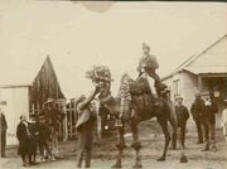
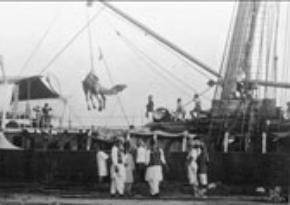

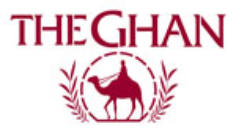
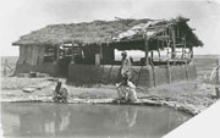
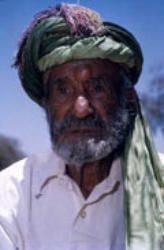
Australia’s Muslim Cameleers exhibition pictures and dialogue courtesy ABC Alice Springs.
…. CLICK TO VIEW
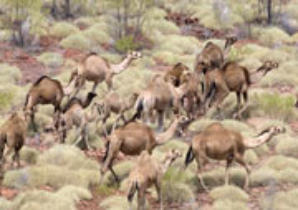

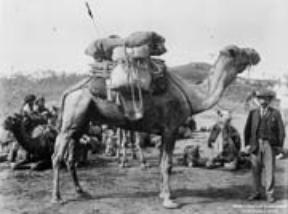
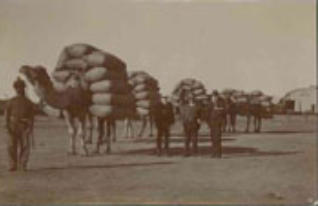
The above information and more can be accessed on the Australian Government website http://www.australia.gov.au/about-australia/australian-story/afghan-cameleers
The first camel in Australia.
The
Phillips
brothers,
(Henry
Weston
Phillips
(1818-
1898);
George
Phillips
(1820-1900);
G
M
Phillips
(?-
?))
bought
nine
camels
at
Tenerife
in
the
Canary
Islands.
Four
or
six
of
the
beasts
were
loaded
aboard
the
SS
Apolline
which
had
been
chartered
by
Henry
in
London.
The
Apolline,
under
Captain
William
Deane,
docked
at
Port
Adelaide
in
South
Australia
on
12
October
1840
and
the
sole
surviving
beast,
named
Harry, became the first camel in Australia.
By
the
mid–1800s,
exploration
in
Australia
was
at
its
peak
with
expeditions
setting
out
almost
monthly.
The
race
to
map
the
continent,
locate
natural
resources
or
find
new
places
to
settle
moved
away
from
the
coast
and
further
into
the
inhospitable
heart
of
Australia.
It
was
soon
obvious
that
the
traditional
horses
and
wagons
used
for
such
expeditions
were
not
suitable
in
this
strange
and
foreign
land.The
solution
to
the
problem
of
finding
suitable
transport
for
inland
exploration
and
travel
was
to
bring
in
camels.
As
nobody
at
the
time
knew
how
to
handle
camels,
cameleers
were
recruited
to
Australia
as
well.
The
introduction
of
camels
and
the
so-called
'Afghan'
cameleers
proved
to
be
a
turning
point
in
the
exploration and development of the Australian interior.
Afghan and Decorated Camel
Afghan
and
Decorated
Camel,
1901.
Image
courtesy
of the State Library of South Australia: B 14739.
For
a
short
period
of
time
from
the
1860s
to
the
early
1900s, these cameleers and their 'ships of the desert'
became
the
backbone
of
the
Australian
economy.
They
accompanied
exploration
parties,
carrying
supplies
and
materials
where
horses
and
oxen
could
not.
They
carted
supplies,
mail
and
even
water
to
remote
settlements.
They
transported
the
supplies,
tools
and
equipment
needed
for
the
surveying
and
construction
of
some
of
Australia's
earliest,
and
greatest,
infrastructure
projects,
such
as
the
Overland
Telegraph
and
Trans-
Australian Railway.
The first cameleers
In
the
1800s,
explorers,
settlers,
ranchers
and
prospectors
sought
to
unlock
the
mystery
and
potential
of
the
vast,
inhospitable
interior
of
Australia.
Horses,
and
to
a
lesser
degree
donkeys
and
bullocks,
were
the
traditional
beasts
of
burden
on
early
expeditions
into
Australia's
interior.
Many
of
these
expeditions
ended
in
disaster
and
tragedy.
As
well
as
requiring
regular
watering
and
large
stocks
of
feed,
horses
were
easily
exhausted
by
the
tough
and
often
sandy
ground
and
supposedly
'spooked'
by
the
Australian terrain.
One
camel
being
winched
over
the
side
of
the
boat
while a number of Afghans watch.
Unloading camels at Port Augusta, ca.1920.
Image
courtesy
of
the
State
Library
of
South
Australia: B 68916.
A 'solution to the problem'
As
early
as
1839,
camels
were
proposed
as
the
solution
to
the
problem
of
transport
while
exploring.
The
first
expedition
to
use
a
camel
was
the
1846
Horrocks
expedition.
'Harry',
as
the
camel
was
named
by
the
party,
proved
the
worth
of
using
camels
in
expeditions.
In
1846
a
Melbourne
newspaper
reported
that
the
camels
could
carry:
from
seven
to
eight
hundred
pounds
weight
...
they
last
out
several
generations
of
mules
...
the
price
paid
for
them
does
not
exceed
one
half
of
that
paid
for
mules
...
and
it
is
proved
that
these
'ships
of
the
deserts'
of
Arabia
are
equally adaptable to our climate.
Other
small
successes
followed
and
by
1858,
many
prominent
Australians
were
calling
for
the
introduction
of
camels,
including
South
Australian
Governor,
Richard MacDonnell:
“I
despair
of
much
being
achieved
even
with
horses;
and
I
certainly
think
we
have
never
given
explorers
fair
play
in
not
equipping
them
with
camels
or
dromedaries
and
waterskins,
which
in
Africa
I
found
the best methods of carrying liquid.”
Governor
Richard
MacDonnell
to
Charles
Sturt
10
August
1858.
Quoted
in
Mrs
Napier
Sturt's
'Life
of
Charles Sturt' (1899)
.
Purchase and recruitment
At
the
same
time,
the
Victorian
Expedition
Committee
commissioned
George
Landell,
a
well-known
horseman
who
exported
to
India,
to
buy
camels
and
recruit
cameleers,
because
'the
camels
would
be
comparatively
useless
unless
accompanied
by
their
native
drivers'
(from
VEE
committee
minutes,
19
May
1859).
The departure of the Burke and Wills expedition.
The
departure
of
the
Burke
and
Wills
expedition,
1881, Lithograph. Image courtesy of the
State Library of Victoria: mp010346.
In
1860,
24
camels
and
three
cameleers
from
arrived
in Melbourne to join the Burke and Wills
expedition.
Although
this
expedition
ended
in
disaster
with the loss of many lives, including those
of
Burke
and
Wills,
the
camels
again
proved
their
ability to survive the harsh and dry conditions of
the Australian outback.
By
the
late
1860s,
most
Australian
states
were
importing
camels
and
cameleers.
In
1866,
South
Australian
Samuel
Stuckey
brought
in
more
than
100
camels
and
31
cameleers.
Over
the
next
decade,
more
and
more
camels
and
cameleers
were
brought
to
Australia
as
breeding
programs
and
trading
routes
were
established.
It
is
estimated
that
from
1870
to
1900
alone,
more
than
2,000
cameleers
and
15,000
camels came to Australia.
Servicing infrastructure projects
The
cameleers
were
also
instrumental
in
the
success
of
some
of
early
Australia's
most
ambitious
infrastructure
projects.
They
carried
food
and
supplies
to
the
surveying
and
construction
teams
working
on
the
Overland
Telegraph,
which
ran
through
the
heart
of
the
continent
between
Adelaide
and
Darwin.
Once
the
project
was
completed,
they
continued
to
carry
supplies
and
mail
to
the
settlements
and
townships
which sprang up along the line.
They
also
operated
supply
and
equipment
trains
during
the
development
of
the
rail
link
between
Port
Augusta
and
Alice
Springs,
which
became
known
as
the
Afghan
Express,
and
later
the
Ghan.
The
Ghan's
emblem
is
an
Afghan
on
a
camel
in
recognition
of
their
efforts
in
opening
up
the
inhospitable
interior
to
the rest of Australia.
The cameleers
The Ghan Logo
The
Ghan
logo.
Image
courtesy
of
Great
Southern
Rail Limited.
The
cameleers
were
collectively
known
as
'Afghan'
cameleers.
While
some
were
originally
from
Afghanistan,
others
came
from
countries
such
as
Baluchistan,
Kashmir,
Sind,
Rajastan,
Egypt,
Persia,
Turkey
and
Punjab,
so
spoke
a
variety
of
languages.
Their
common
bond
was
their
Islamic
religion
and
the
fact
that
they
were
almost
exclusively
young
or
middle-aged men.
Not quite welcome
Almost
all
of
the
cameleers
who
came
to
Australia
during
this
period
faced
enormous
hardship.
While
their
skills
were
needed
and
mostly
appreciated,
they
were
largely
shunned
by
the
European
communities.
Indeed, racism and anger towards them was rife.
The Mosque, Marree
The
Mosque
at
Hergott
Springs.
The
pool
in
the
foreground
was
used
by
worshippers
for
washing
their feet before
entering
the
Mosque,
ca.1884.
Image
courtesy
of
the
State Library of South Australia: B 15341.
'Ghan Tours'
The
vast
majority
of
cameleers
arrived
in
Australia
alone,
leaving
wives
and
families
behind,
to
work
on
three
year
contracts.
They
were
either
given
living
quarters
on
a
breeding
station,
such
as
Thomas
Elder's
Beltana,
or
marginalised
on
the
outskirts
of
towns
and
settlements.
It
was
not
uncommon
for
outback
towns
to
have
three
distinct
areas—one
for
Europeans,
one
for
Aboriginals
and
one
for
cameleers,
which
became
known
as
Afghan,
or
Ghan,
towns.
This
social
division
was
even
reflected
in
the
town
cemeteries,
such
as
those
of
Farina
and
Marree.
But
while
it
was
extremely
rare
for
the
cameleers
to
interact
with
Europeans,
there
was
more
acceptance
by
the
local
Aboriginal
populations.
Indeed,
some
cameleers
married
local
Aboriginal
women
and
had
families here.
In
the
so-called
Ghan
towns,
cameleers
would
often
build
a
mosque
that
would
not
only
serve
as
a
place
of
worship,
but
as
a
gathering
place
that
offered
the
cameleers
a
sense
of
community
that
they
could
not
find
elsewhere.
The
remains
of
the
oldest
mosque
in
Australia,
built
in
1861,
are
near
Marree
(Hergott
Springs)
in
South
Australia.
This
was
once
one
of
the
country's
most
important
camel
junctions
and
in
its
heyday was called Little Asia or Little Afghanistan.
Portrait
of
Saidah
Saidel,
last
of
the
Afghan
camel
drivers
Robin
Smith,
Last
of
the
camel
drivers,
unknown.
Image courtesy of Territory Stories: PH0780/0010.
In
some
instances,
European
attitudes
to
the
cameleers
focused
on
their
religion.
In
other
cases,
it
was related to their
perceived
pride
and
independence
as
at
the
time,
Afghanistan
was
really
only
known
to
most
Australians as the country
that
had,
unlike
British
India,
resisted
the
British
forces.
This
perception
was
further
enhanced
in
the
settlers' eyes when
cameleers
on
Beltana
station
went
on
strike—one
of
Australia's first successful strikes.
Relations
on
the
Western
Australian
goldfields
1890s
As
the
cameleers
became
more
established,
many
set
up
their
own
competing
businesses
and
enterprises,
often
resulting
in
ill-will
and
sometimes
even
open
conflict.
One
of
the
most
notable
examples
of
this
was
on
the
Western
Australian
goldfields
in
the
late
1890s.
Years
of
simmering
tensions
between
Afghan
cameleers
and
European
bullock
teamsters
escalated
to
the
point
where
the
cameleers
were
openly
demonised
in
the
press
and
accused
of
various
acts
of
aggression,
including
monopolising
and
befouling
waterholes.
This
resulted
in
Hugh
Mahon,
the
local
federal
Member,
raising
the
issue
with Prime Minister Barton in parliament.
A
subsequent
investigation
by
police
was
ordered
and
the
state's
Police
Commissioner
ultimately
reported
that,
while
there
had
been
many
'reports
and
rumours
of
Afghans
polluting
the
water
and
taking
forcible
possession
of
dams',
there
was
actually
'no
evidence
obtainable'
to
support
these
reports
and
complaints.
In
fact,
the
investigation
found
that
the
only
trouble
'of
a
serious
nature'
was
that
a
cameleer
had
been
shot
and
wounded
by
a
white
teamster
for
failing
to
give
way.
Camel Train
Camel
train
laden
with
chaff
for
interior
stations
in
the
far
North
with
an
Afghan
camel
driver,
ca.1911.
Image
courtesy
of
the
State
Library
of
South
Australia:
B
14808.
Providing
drought
assistance
in
far
western
New
South Wales, 1900s
But
not
all
white
Australians
shunned
the
cameleers.
When William Goss became the first European to
see
Uluru,
he
named
a
nearby
well,
Kamran's
Well,
after his lead cameleer and a nearby hill, Allanah
Hill,
after
another
cameleer.
And
in
1902,
after
the
devastating Federation Drought, the Attorney-
General
received
a
letter
from
a
John
Edwards
stating that:
It
is
no
exaggeration
to
say
that
if
it
had
not
been
for
the
Afghan
and
his
Camels,
Wilcannia,
White
Cliffs,
Tibooburra,
Milperinka
and
other
Towns,
each
centres
of
considerable
population,
would
have
practically ceased to exist.
Contractors and entrepreneurs
As
the
cameleers
became
accustomed
to
the
Australian
landscape
and
people,
many
saw
a
way
to
create
opportunities
for
themselves
by
branching
into
business
on
their
own
or
in
partnership
with
Europeans.
So
successful
were
they
that
by
the
end
of
the
nineteenth
century,
Muslim
merchants
and
brokers dominated the Australian camel business.
Fuzzly Ahmed and Faiz Mahomet
Some
of
the
most
successful
of
the
cameleer
entrepreneurs
included
Fuzzly
Ahmed,
who
worked
the
Port
Augusta–Oodnadatta
line
for
many
years
before
moving
to
Broken
Hill,
and
Faiz
Mahomet,
who
arrived
at
the
age
of
22
and
settled
in
Marree,
where
he
operated
as
a
Forwarding
Agent
and
General
Carrier
before
moving
to
and
setting
up
an
operation
in
the
Coolgardie
goldfields
with
his
brother,
Tagh
Mahomet.
Abdul Wade
Camels
and
camel
merchants
at
Mt.
Garnet,
Queensland, ca. 1901
Unknown,
Camels
and
camel
merchants
at
Mt.
Garnet,
Queensland,
ca.
1901
[The
man
in
the
suit
and hat,
holding
the
camel,
is
Abdul
Wade].
Image
courtesy
of
the State Library of Queensland: 13127.
But
perhaps
the
most
successful
of
all
the
Afghan
cameleers
was
Abdul
Wade.
Wade
arrived
in
Australia in
1879
and
initially
worked
for
Faiz
and
Tagh
Mahomet.
In 1893, Wade moved to Bourke, NSW, and began
importing
camels
and
recruiting
Afghan
cameleers
for
the recently formed Bourke Camel Carrying Co.,
New South Wales.
In
1895,
Wade
married
widow
Emily
Ozadelle,
with
whom he had seven children, and in 1903 purchased
Wangamanna
station
in
New
South
Wales,
which
he
established
as
a
camel
breeding
and
carrying
business.
At
the
height
of
his
success,
Wade
had
four
hundred
camels and sixty men working for him.
Respected
by
his
employees
and
nicknamed
the
'Afghan
prince',
Wade
worked
hard
at
being
seen
as
an
equal
by
his
Australian
peers.
He
dressed
as
a
European,
educated
his
children
at
top
private
schools
and
even
became
a
naturalised
citizen.
But
success
in
Australian
society
eluded
Wade
and
his
attempts
at
fitting
in
were
ridiculed.
At
the
end
of
the
camel
era,
Wade
sold
his
station
and
returned
to
Afghanistan,
where
he
surrendered
his
Australian
passport.
The end of an era
In
the
early
twentieth
century,
motorised
and
rail
transport
was
becoming
more
common
and
the
need
for
camels,
and
cameleers,
was
slowly
dying.
Ironically,
two
of
the
greatest
contributions
of
the
Afghan
cameleers,
the
Ghan
railway
and
Overland
Telegraph,
were
also
to
herald
the
start
of
their
demise.
Immigration Restriction Act 1901
Certificate
exempting
Said
Kabool
from
the
Dictation
Test,
1916.
Said
Kabool
arrived
in
Australia
in
1896
and worked in
Coolgardie
for
seven
years.
Image
courtesy
of
the
National
Archives
of
Australia:
NAA:
E752,
1916/42,
p. 12.
As
many
of
the
cameleers
were
in
Australia
on
three
year
contracts,
they
would
usually
return
to
their
homes and family
after
each
contract,
before
returning
to
Australia.
Some
discovered
that
they
were
no
longer
granted
permission to return
to
Australia.
Others
found
that
they
now
had
to
sit
the
dictation
test
under
the
Immigration
Restriction
Act,
1901 (which
kept
out
new
cameleers
and
denied
re-entry
to
those
who
left),
or
apply
for
exemption.
Many
were
denied
naturalisation
due to their 'Asian' status.
In
1903,
a
petition
on
behalf
of
more
than
500
Indians
and
Afghans
in
Western
Australia
was
placed
before
the
Viceroy
of
India,
Lord
Curzon.
The
petition
made
four
major
complaints
against
'certain
legislative
restrictions'
facing
the
cameleers:
they
were
unable
to
hold
a
miner's
right
on
the
goldfields;
they
could
not
travel
interstate
for
work,
'except
under
the
most
stringent
conditions';
they
were
not
allowed
to
re-
enter
Australia
if
they
left;
and
they
were
not
able
to
be naturalised. Nothing was to come of their petition.
Rail and road transport
Feral
Camels
cover
approximately
40%
of
land
area
in the NT. Image courtesy of the Northern Territory
Government
Natural
Resources,
Environment,
The
Arts and Sport.
By
the
1930s,
Australia's
inland
transport
was
controlled
by
rail
and,
increasingly,
road
networks.
Facing
the
prospect
of
no
employment
and
a
sometimes
hostile
government
and
people,
many
of
the
cameleers
returned
to
their
homelands,
some
after
decades
of
living in Australia. Others remained and turned to
other
trades
and
means
of
making
a
living.
Rather
than see their camels shot, they released them into
the
wild,
where
they
have
since
flourished.
In
2007,
the estimated feral camel population of Australia
was
around
1
000
000,
approximately
half
of
which
were in Western Australia.
The last of the cameleers
By
1940,
few
cameleers
remained.
Philip
Jones
relates
the
tale
of
some
of
the
last
of
the
Afghan
cameleers
in
reCollections,
the
Journal
of
the
National Museum of Australia:
“In
the
Adelaide
summer
of
1952
a
young
Bosnian
Muslim
and
his
friends,
newly
arrived
immigrants,
pushed
open
the
high
gate
of
the
Adelaide
mosque
As
Shefik
Talanavic
entered
the
mosque
courtyard
he
was
confronted
by
an
extraordinary
sight.
Sitting
and
lying
on
benches,
shaded
from
the
strong
sunshine
by
vines
and
fruit
trees,
were
six
or
seven
ancient,
turbaned
men.
The
youngest
was
87
years
old.
Most
were
in
their
nineties;
the
oldest
was
117
years
old.
These
were
the
last
of
Australia's
Muslim
cameleers...
Several
had
subscribed
money
during
the
late
1880s
for
the
construction
of
the
mosque
which
now,
crumbling and decayed, provided their last refuge.”
It
is
only
in
recent
years,
with
the
South
Australian
Museum's
Australian
Muslim
Cameleers
exhibition
(developed
with
support
from
the
Visions
of
Australia
program)
and
book,
that
the
story
and
the
contribution
of
these
pioneers
to
Australia's
history
and
development has been told.









Australia’s Muslim Cameleers exhibition pictures &
dialogue courtesy ABC Alice Springs.
…. CLICK TO VIEW
The above information and more can be accessed on the
Australian Government website
http://www.australia.gov.au/about-australia/australian-story
/afghan-cameleers






















